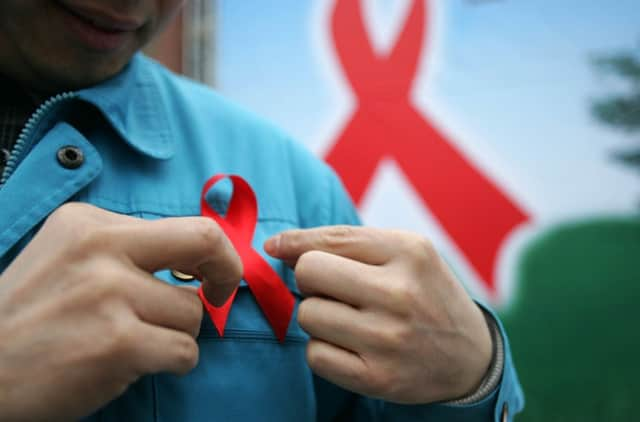Lyndsay Buckland: In danger of dying of ignorance


There was a time not so long ago when watching a TV ad break could mean scaring the living daylights out of yourself.
Public information broadcasts warning of dangers to our health are always designed to have the maximum impact. A particularly effective recent ad highlights the effects of passive smoking, with sinister coils of smoke in the shape of snakes which entwine themselves around young children.
Advertisement
Hide AdAdvertisement
Hide AdBut these are nothing compared with those in the 1980s alerting us to the risks of HIV and Aids. The sight of that huge “Aids” tombstone alongside the slogan “Don’t die of ignorance” shook up many people slumped in a stupor on their sofas.
In his trademark ominous tones, actor John Hurt warned them: “There is now a danger that has become a threat to us all.
“It is a deadly disease and there is no known cure.”
It was the world’s first major government-sponsored national Aids awareness drive.
And despite claims of panic-mongering and that children would be left terrified, the campaign was hailed a success and copied around the world. Other countries were slower to pick up the baton and there were suggestions this could have led to higher rates of disease than were seen in the UK.
These days it is easy to think that HIV is a problem of the past, as it seems to come up relatively infrequently in our public consciousness.
It has been overtaken by other global health concerns, most recently Ebola, which poses much less of a threat to us living in the UK but has commanded a huge amount of attention.
There are similarities to HIV: there is no proven cure, no proven vaccine and it is also having a much bigger impact on countries in Africa than it is here.
Still, a terror seems to have struck in the same way that the TV campaigns of the 1980s had an effect on how we thought about HIV.
Advertisement
Hide AdAdvertisement
Hide AdAnd there is no doubt that HIV is still with us in the UK, and it shows no signs of going away any time soon.
Figures published this week show that in the first six months of this year, 170 people in Scotland received an HIV diagnosis and it is now estimated that 4,705 are living with HIV in the country. A further 2,000 are thought to have died.
If the same pattern of diagnoses seen so far this year is continued into the second half of 2014, this will put us on course for a similar number of cases as seen last year, when 354 people in Scotland were told they had HIV.
Indeed, the numbers diagnosed in recent years show little change – 348 cases in 2012, 364 in 2011 and 359 in 2010. Even a decade ago, in 2004, there were 359 people diagnosed.
We seem to have flatlined.
In many cases – 52 of the 170 diagnoses seen so far this year – people acquired HIV outside of the UK, often in countries where the virus still runs rife.
But that still leaves the majority whose infection happened inside the UK. This is not just a foreign problem we can forget.
It is also not a problem limited to gay men, with around a 50/50 split in homosexual and heterosexual transmissions. Injecting drug users now account for only a small number of new cases.
Is it that we have accepted that this is as far as we can go in reducing cases of the disease? Surely we should be aiming to cut numbers further, and certainly this is what sexual health charities are working to do by continuing to push their safe-sex messages.
Advertisement
Hide AdAdvertisement
Hide AdBut we appear to lack the same drive and bravery that led to those compelling campaigns of the 1980s which shocked us into action. We also successfully tackled the plague of HIV among drug-users in Edinburgh with a co-ordinated approach which appears lacking in efforts to reduce our toll further now.
A major concern remains the large numbers of people who currently have HIV but have not yet been diagnosed. They may be unwittingly passing on the infection to every sexual partner until one finally has a test which cascades the devastating news to others in the chain.
According to the Terrence Higgins Trust, one in five people living with HIV in the UK remains unaware that they have the virus.
As well as the risks of transmission to others, without treatment their immune system is at risk of severe damage that can cause complicated medical conditions.
But maybe the effectiveness of these new treatments for HIV, which now mean people can live relatively normal lives – often dying of other conditions before Aids strikes – has led to some viewing the virus in a much more blasé fashion.
After all, if the NHS can give you drugs to keep you alive even with HIV, why worry about trying to protect yourself?
It is hard to believe that people really think like this: HIV is still a lifelong, life-threatening disease. But perhaps it holds less fear as a result of these improved treatments, and subconsciously that is affecting how we view the virus now, compared with the 1980s. Would we be as fearful of Ebola now if vaccines and treatments were readily available?
Regular testing for HIV among those groups most at risk is also vital to get people diagnosed as soon as possible.
Advertisement
Hide AdAdvertisement
Hide AdThe fact that HIV has now fallen off many people’s radar means that a new shock campaign, bringing back some of the fear factor of the past, isn’t the worst idea.
Softly softly just isn’t working any more. Possibly, as we’re harder to shock than ever before, the campaigns are going to have to step up a gear. If you were scared before, prepare to be terrified.